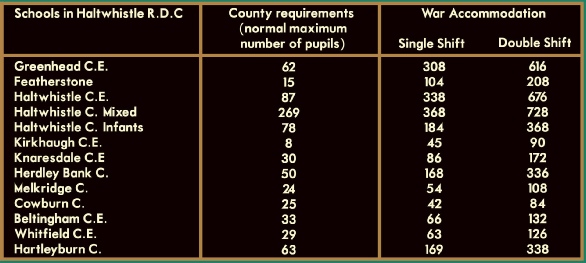
Haltwhistle Partnership © Use of images is permitted for non commercial purposes
| Heritage Lottery Funded Made with Serif software ![]()
![]()

Local schools and homes were expected to receive, house, feed and teach remarkable numbers of children. A school such as Kirkhaugh, for example, with eight pupils was expected to take an additional 82 children, the three Haltwhistle schools, 434 and little Greenhead School, an incredible 554! In the event the numbers were far fewer and many who came at the outbreak of war in September 1939 had returned to their homes before Christmas.

As Britain came to realise that war was inevitable, preparations began to ensure the safety of the children – the hope for the future. Tyneside was a major centre for armament production and could expect to be a target for German bombs: the long sandy beaches of the Northumberland coast were ideal for a German invasion and the whole coastal area was vulnerable to shelling from the German navy.
Haltwhistle and the surrounding villages were far enough inland to be safer from attack and in May 1939, local head teachers received their instructions to prepare for an influx of hundreds of children from the city and coast.

Although the Haltwhistle area was considered at low risk of bombing there was always the chance of air attack. Head teachers were advised on the best course of action should enemy air craft approach..
When the air raid warning signal is given........
“Teachers should be definitely instructed, some to see that children do not loiter on the highway but scatter to their homes without delay, others to see that that pupils who cannot get home are distributed through the school rooms... or made to scatter in the school playing field within shelter of hedges or fences.”
“Pupils should be told not to stop and watch aircraft, but, in the event of seeing any, to take shelter in the roadside ditches or in the nearest houses. In no circumstances must they stand in the open roads and gaze upwards at the aircraft.”
There were no air raid shelters built for schools in the area (or provided for house-holders) so head teachers were advised to construct cover trenches for the children and staff.
“..cover trenches must be sufficient to hold approximately one-third of the pupils of the school. They should be about four feet deep... made as neatly as possible with sloping floors and a sump for drainage purposes. .....Soil from the excavation should not be placed on top of the trenches but cleared away... loose soil or evidence of recent digging are very plainly seen from the air.”

Doreen Gregg remembers being at School in Brampton. “ I remember during the war... we were digging trenches... we were down beside a long, long wall and we had to dig very deep and if there was a raid we all went there.”
The evacuation begins
From Featherstone School Log Book 1939
Aug. 31st
Wireless message broadcasted that children from Newcastle area were to be evacuated to this area on the morrow. In accordance to the instructions there given the school is to be closed until further notice. The teachers were to report as usual to be of assistance to the Billeting Authority.
Sept 1st.
Miss Wilson and Head Teacher present, but no class. A letter from the Educ. Comm. arrived stating that teachers were to attend school today, Saturday and Sunday and schools were to resume on Monday in the event of there being no war in the meantime. In the case of war, the schools would continue to be closed until Monday Sept. 11th.

Sept 25th Single shift System commenced today..... 80 children were on the registers.
Where schools were too small to accommodate all the children now on the registers, as at Beltingham and Melkridge, Church Halls were pressed into use.
From Melkridge School Log book:
Oct. 9th 1939 Melkridge Church hall has been hired as an additional school premises. Single shift system started, Juniors under Mr. Alexander in the Church Hall, remainder in school.
But as the anticipated attack on Britain did not materialise many evacuees returned home.
Nov. 22nd Use of Church Hall discontinued. All the children now in the school room, as many have returned home.

Sept. 1st
33 children and three teachers were evacuated from Delaval Road School, Newcastle, into this area. Most of them are lodged at Featherstone Castle, while the remainder are billeted in houses in the immediate vicinity.
Sept. 3rd
Great Britain declared herself to be in a state of war with Germany this morning at 11am. Such being the case, school will be closed for evacuation purposes during the whole of the week.
Sept.6th
Children from Wallsend Roman Catholic School evacuated today. 23 have come to Park Village accompanied by a teacher.....Arrangements are to be made for a Double Shift system here. Featherstone Children with a few private evacuees to attend the morning session 9 a.m. to 12.30 p.m., while the children from Delaval Road and Wallsend ( evacuated under the Government scheme) will attend from 1.30 to 5 p.m.
Sept 11th ....
there were 50 children on the register for the morning session. The afternoon session.there were present 29 Government scheme evacuees and 2 private evacuees.

Teachers evacuated with their classes were often billeted with local people. Sometimes however a large house was requisitioned for numbers of evacuees and in these cases teachers were sent with the children to look after them with the assistance of a housekeeper.
At the start of the war, a number of children evacuated from the Newcastle area were billeted together in this way at Featherstone Castle but as time went on they were moved to families in Haltwhistle and transferred from Featherstone School to the Haltwhistle Schools.